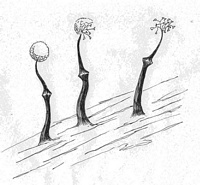|
 Clastoderma debaryanum Clastoderma debaryanum
BiostatusPresent in region - Indigenous. Non endemic
Images (click to enlarge)
Caption: Three fruiting bodies of Clastoderma debaryanum. Note the prominent oval swelling on the stalk. Each fruiting body is approximately 1 mm tall.
Owner: S.L. Stephenson |
Article: Stephenson, S.L. (2003). Myxomycetes of New Zealand. Fungi of New Zealand. Ngā Harore o Aotearoa 3: xiv + 238 p. Hong Kong: Fungal Diversity Press.
Description: Fruiting body a stalked sporangium, usually scattered, 1.0–1.3 mm tall. Sporotheca globose, erect or slightly nodding, light brown, 0.1–0.2 mm in diameter. Stalk slender, filled with granular material below but translucent and brown above, with the two portions usually separated by a prominent oval swelling. Hypothallus inconspicuous. Peridium persisting in mature fruiting bodies only as a basal collar. Columella short or absent. Capillitium arising from the apex of the columella or the base of the sporotheca and consisting of a network of pale brown threadlike elements, with some of the extremities expanded to form small platelets. Spores bright rosaceous-brown in mass, pallid by transmitted light, covered with small warts, 8–11 µm in diameter. Plasmodium at first watery white and then becoming darker with age.
Habitat: Decaying wood or bark; sometimes occurring on old, weathered sporocarps of perennial fungi and also not uncommon on the bark of living trees in moist chamber culture.
Distribution: Probably cosmopolitan and often abundant in the tropics (Martin & Alexopoulos 1969). First reported from New Zealand by Cheesman & Lister (1915), based on a specimen collected in Bay of Plenty. Also known from Auckland, Dunedin, Southland, and Stewart Island.
Notes: This species is probably more common in New Zealand than available records would indicate, but it is easily overlooked as a result of the small size of the fruiting bodies. Most descriptions of Clastoderma debaryanum mention the presence of peridial fragments that remain attached to the tips of capillitial branches. Frederick et al. (1986) reported that these structures are actually portions of the capillitium.
|